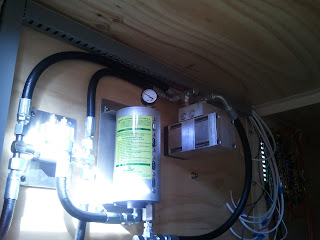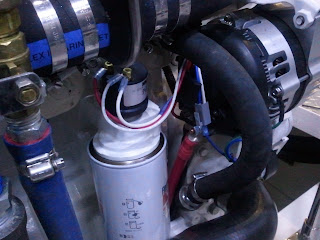Monday, January 9, 2012
Wiring and a few other projects
A few recent projects... After successfully test running the engine (in jury rigged form), I set about to run all the wiring between the engine and the wheelhouse, including the control/gauge panel in the engine room. This was rather involved as it also meant hooking up all the final wiring for the alternator charging system and starter battery circuit. The way we are now configured, you can start, stop, and monitor all the engine functions from either the engine room or the wheelhouse. The engine driven battery charging system consists of a high output alternator controlled by an external regulator. The regulator can be programmed for a lot of fancy features but right now we just have it configured for gel cell battery charging, slow ramp up (to avoid hard load on the engine at start-up), battery temp sensing, and alternator temp sensing. All the charging current goes from the alternator directly into the big house battery bank which basically runs the boat. The engine starting battery is used only for cranking the engine, and gets its charge from the house bank via a Duo Charge (an automatic dc-dc charger that "spills over" current from the house battery bank to charge the starter battery when it senses that house battery charging is taking place). So far everything is working as advertised. The only glitch left is the tachometer which is not working despite many checks on the wiring and ensuring the right voltage in the right places from the magnetic inductive pick-up on the flywheel. Have to do some more research on that one... As soon as we decide on a wheelhouse instrument layout, I'll be building the main helm instrument console, and hooking up all the basic wheelhouse electronics. I finished making up some neat little fuel vents out of some bell reducers with stainless rings to hold the 30/30 mesh screens in place. These are now installed on the fuel vent lines and the tanks can breath easy. Also installed a plate type heat exchanger that will transfer heat between the engine cooling circuit and the diesel furnace heating circuit. This will allow the furnace to preheat the engine for easier starting when temps are low, and allow excess engine heat (when running) to feed the heater circuit so the diesel furnace burner doesn't have to cycle on as much when we are underway and need vessel heating or domestic hot water. I rebuilt another set of used Racor fuel filters that I got my hands on. One of these will feed clean fuel to the diesel furnace and the other will be for future additions (maybe a small engine powered DC generator for additional battery charging?). Engine room is really coming together and it feels like we are on the downhill side of the machinery installation...
Subscribe to:
Comments (Atom)




















